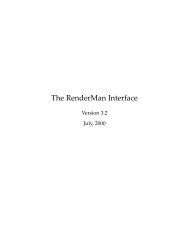Controlling Fluid Simulations with Custom Fields in Houdini Master ...
Controlling Fluid Simulations with Custom Fields in Houdini Master ...
Controlling Fluid Simulations with Custom Fields in Houdini Master ...
Create successful ePaper yourself
Turn your PDF publications into a flip-book with our unique Google optimized e-Paper software.
Figure 2: High resolution 2d uid conta<strong>in</strong>ers controlled by <strong>in</strong>formation fromprojected particles created by ILM. Image taken from [10]Figure 3: Advect<strong>in</strong>g the simulation <strong>with</strong> curl noise where turbulent energy isdetected. Image taken from [14]tion can be raised quite high. The <strong>in</strong>terest<strong>in</strong>g part is that the relatively smallamount of particles are used as a way to dene the high resolution elds. Theparticles represent a custom eld, this h<strong>in</strong>ts towards the idea that the customeld does not need to have a very high resolution as some of the simulationsonly used 20.000 to 100.000 particles.3.3 Research3.3.1 Introduc<strong>in</strong>g noise <strong>in</strong> the velocity eldAnother example of the use of a custom eld to give more <strong>in</strong>terest<strong>in</strong>g results<strong>in</strong> uid simulation is the <strong>in</strong>troduction of curl-noise for procedural uid ow [3].They generate turbulent velocity elds based on Perl<strong>in</strong> noise. This type of noiseis procedural but could just as well be added to uid simulations, which is whatis be<strong>in</strong>g done <strong>in</strong> [14] <strong>with</strong> the additional condition that the curl noise is notadvect<strong>in</strong>g the velocity everywhere, but only where their physically motivatedenergy model dictates it as can be seen <strong>in</strong> Figure 3.5















